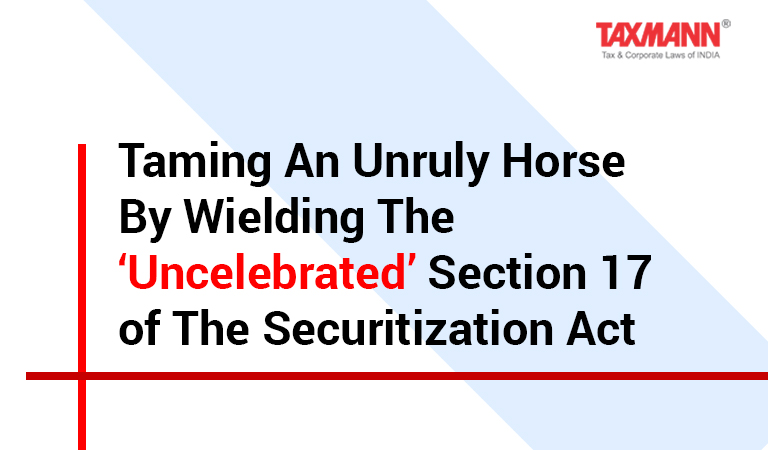Taming An Unruly Horse By Wielding The ‘Uncelebrated’ Section 17 of The Securitization Act
- Blog|News|FEMA & Banking|
- 2 Min Read
- By Taxmann
- |
- Last Updated on 23 September, 2021

[2021] 130 taxmann.com 303 (Article)
Distinguishably since its enactment and inception, the Securitisation and Reconstruction of Financial Assets and Enforcement of Security Interest Act, 2002 (“SARFAESI Act/Securitization Act”) has evinced to be one of the most significant pieces of legislation, aimed towards the facilitation of “easy and faster recovery of loans advanced by banks and financial institutions.” The Securitization Act was legislated, succeeding the enactment of the Recovery of Debts and Bankruptcy Act (“RDB Act”) in the year 1993, under an acknowledgment that the RDB Act had failed to achieve its intended aims and objectives. In this regard, the Hon’ble Apex Court2, while accentuating the motives behind the enactment of the Securitization Act, observed, “2002 Act was brought into force as a result of two committee reports which opined that recovery of debts due to banks and financial institutions was not moving as speedily as expected, and that, therefore, certain other measures would have to be put in place in order that these banks and financial institutions would better be able to recover debts owing to them.” Simultaneously, the Hon’ble Court in M.D. Frozen Foods Exports (P) Ltd. v. Hero Fincorp Ltd.3, appreciating the scope of the said enactment, remarked, “[t]he scheme of the SARFAESI Act sets out an expeditious, procedural methodology, enabling the bank to take possession of the property for non-payment of dues, without intervention of the court.” Indisputably, the Securitization Act envisions a comprehensive mechanism for the enforcement of security interest4 by secured creditor(s)5, with limited or no judicial intervention. However, considering the vast and seemingly unbridled expanse of this faculty of secured creditors, a proclivity of its misemployment and abuse cannot be ruled out. Consequently, in order to curtail any such unrestricted and untrammeled deployment of secured creditors’ said potentiality, inherent safeguards, inter alia, in form of the provisions that under section 17are envisioned under the SARFAESI Act. Evidently, a justification for the incorporation of such an armour alongside an independent recovery mechanism by secured creditor(s) under the SARFAESI Act seems to be predicated on a need to establish an equilibrium between inconsistent yearnings, besides guaranteeing that none of the parties to such conflicting interests feel excepted in their potentiality to seeks redressal of their concerns.
Click Here to Read the Complete Article
Disclaimer: The content/information published on the website is only for general information of the user and shall not be construed as legal advice. While the Taxmann has exercised reasonable efforts to ensure the veracity of information/content published, Taxmann shall be under no liability in any manner whatsoever for incorrect information, if any.

Taxmann Publications has a dedicated in-house Research & Editorial Team. This team consists of a team of Chartered Accountants, Company Secretaries, and Lawyers. This team works under the guidance and supervision of editor-in-chief Mr Rakesh Bhargava.
The Research and Editorial Team is responsible for developing reliable and accurate content for the readers. The team follows the six-sigma approach to achieve the benchmark of zero error in its publications and research platforms. The team ensures that the following publication guidelines are thoroughly followed while developing the content:
- The statutory material is obtained only from the authorized and reliable sources
- All the latest developments in the judicial and legislative fields are covered
- Prepare the analytical write-ups on current, controversial, and important issues to help the readers to understand the concept and its implications
- Every content published by Taxmann is complete, accurate and lucid
- All evidence-based statements are supported with proper reference to Section, Circular No., Notification No. or citations
- The golden rules of grammar, style and consistency are thoroughly followed
- Font and size that’s easy to read and remain consistent across all imprint and digital publications are applied



 CA | CS | CMA
CA | CS | CMA
